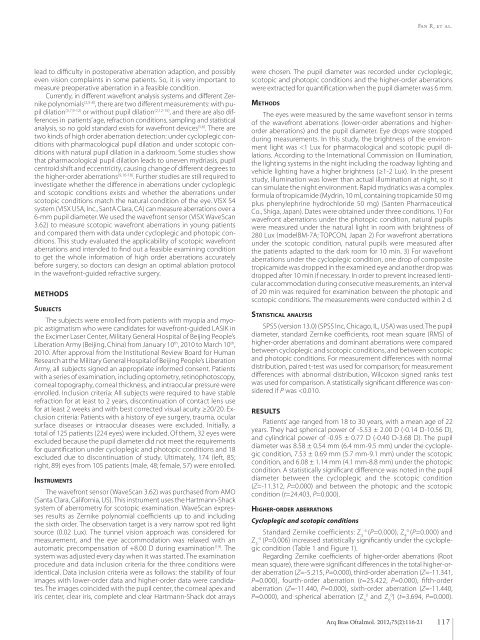São Paulo (SP) - Conselho Brasileiro de Oftalmologia
São Paulo (SP) - Conselho Brasileiro de Oftalmologia
São Paulo (SP) - Conselho Brasileiro de Oftalmologia
You also want an ePaper? Increase the reach of your titles
YUMPU automatically turns print PDFs into web optimized ePapers that Google loves.
Fan R, et al.<br />
lead to difficulty in postoperative aberration adaption, and possibly<br />
even vision complaints in some patients. So, it is very important to<br />
mea sure preoperative aberration in a feasible condition.<br />
Currently, in different wavefront analysis systems and different Zer -<br />
nike polynomials (2,5-8) , there are two different measurements: with pu -<br />
pil dilation (3,7,9-12) or without pupil dilation (2,12-15) , and there are also dif -<br />
ferences in patients’ age, refraction conditions, sampling and statistical<br />
analysis, so no gold standard exists for wavefront <strong>de</strong>vices (5,6) . There are<br />
two kinds of high or<strong>de</strong>r aberration <strong>de</strong>tection: un<strong>de</strong>r cycloplegic conditions<br />
with pharmacological pupil dilation and un<strong>de</strong>r sco topic conditions<br />
with natural pupil dilation in a darkroom. Some studies show<br />
that pharmacological pupil dilation leads to uneven my driasis, pupil<br />
centroid shift and eccentricity, causing change of different d e grees to<br />
the higher-or<strong>de</strong>r aberrations (9,16-18) . Further studies are still re quired to<br />
investigate whether the difference in aberrations un<strong>de</strong>r cycloplegic<br />
and scotopic conditions exists and whether the aberrations un<strong>de</strong>r<br />
scotopic conditions match the natural condition of the eye. VISX S4<br />
system (VISX USA, Inc., SantA Clara, CA) can measure aber rations over a<br />
6-mm pupil diameter. We used the wavefront sensor (VISX WaveScan<br />
3.62) to measure scotopic wavefront aberrations in young patients<br />
and compared them with data un<strong>de</strong>r cycloplegic and photopic conditions.<br />
This study evaluated the applicability of scotopic wavefront<br />
aberrations and inten<strong>de</strong>d to find out a feasible examining condition<br />
to get the whole information of high or<strong>de</strong>r aberrations accurately<br />
be fore surgery, so doctors can <strong>de</strong>sign an optimal ablation protocol<br />
in the wavefront-gui<strong>de</strong>d refractive surgery.<br />
METHODS<br />
SUBJECTS<br />
The subjects were enrolled from patients with myopia and myopic<br />
astigmatism who were candidates for wavefront-gui<strong>de</strong>d LASIK in<br />
the Excimer Laser Center, Military General Hospital of Beijing People’s<br />
Liberation Army (Beijing, China) from January 10 th , 2010 to March 10 th ,<br />
2010. After approval from the Institutional Review Board for Human<br />
Research at the Military General Hospital of Beijing People’s Liberation<br />
Army, all subjects signed an appropriate informed consent. Patients<br />
with a series of examination, including optometry, retinophotoscopy,<br />
corneal topography, corneal thickness, and intraocular pressure were<br />
enrolled. Inclusion criteria: All subjects were required to have stable<br />
refraction for at least to 2 years, discontinuation of contact lens use<br />
for at least 2 weeks and with best corrected visual acuity ≥20/20. Exclusion<br />
criteria: Patients with a history of eye surgery, trauma, ocular<br />
surface diseases or intraocular diseases were exclu<strong>de</strong>d. Initially, a<br />
total of 125 patients (224 eyes) were inclu<strong>de</strong>d. Of them, 32 eyes were<br />
exclu<strong>de</strong>d because the pupil diameter did not meet the requirements<br />
for quantification un<strong>de</strong>r cycloplegic and photopic conditions and 18<br />
exclu<strong>de</strong>d due to discontinuation of study. Ultimately, 174 (left, 85;<br />
right, 89) eyes from 105 patients (male, 48; female, 57) were enrolled.<br />
INSTRUMENTS<br />
The wavefront sensor (WaveScan 3.62) was purchased from AMO<br />
(Santa Clara, California, US). This instrument uses the Hartmann-Shack<br />
system of aberrometry for scotopic examination. WaveScan expresses<br />
results as Zernike polynomial coefficients up to and including<br />
the sixth or<strong>de</strong>r. The observation target is a very narrow spot red light<br />
source (0.02 Lux). The tunnel vision approach was consi<strong>de</strong>red for<br />
mea surement, and the eye accommodation was relaxed with an<br />
automatic precompensation of +8.00 D during examination (19) . The<br />
sys tem was adjusted every day when it was started. The examination<br />
procedure and data inclusion criteria for the three conditions were<br />
i<strong>de</strong>ntical. Data inclusion criteria were as follows: the stability of four<br />
images with lower-or<strong>de</strong>r data and higher-or<strong>de</strong>r data were candidates.<br />
The images coinci<strong>de</strong>d with the pupil center, the corneal apex and<br />
iris center, clear iris, complete and clear Hartmann-Shack dot arrays<br />
were chosen. The pupil diameter was recor<strong>de</strong>d un<strong>de</strong>r cycloplegic,<br />
sco topic and photopic conditions and the higher-or<strong>de</strong>r aberrations<br />
were extracted for quantification when the pupil diameter was 6 mm.<br />
METHODS<br />
The eyes were measured by the same wavefront sensor in terms<br />
of the wavefront aberrations (lower-or<strong>de</strong>r aberrations and higheror<strong>de</strong>r<br />
aberrations) and the pupil diameter. Eye drops were stopped<br />
during measurements. In this study, the brightness of the environment<br />
light was

















